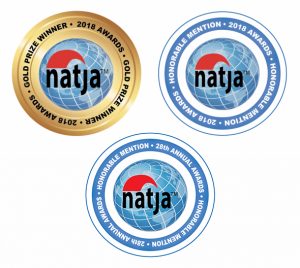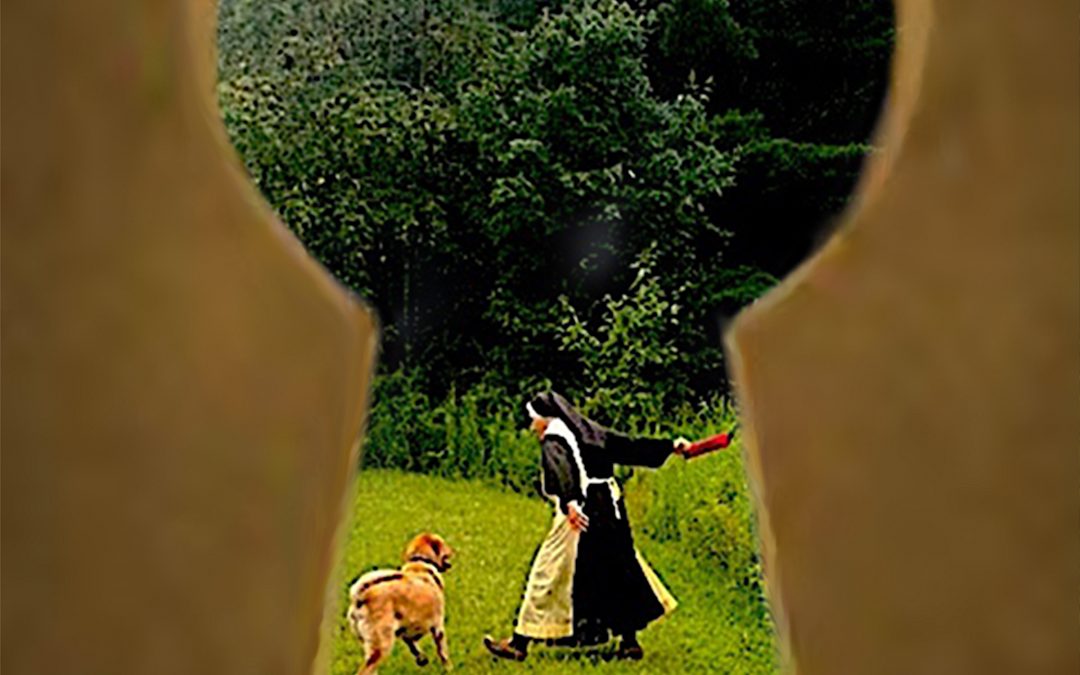
by Pat Wetzel | Jan 7, 2020 | Guest Post, Road Trip, The Story
This guest post by Bev Thompson combines the best of travel, family and faith in a most unexpected set of circumstances, in a retreat at a Benedictine Monastery.
Faith Has A Voice: Serendipity – Stillness – Strength
by Bev Thompson
The idea of ‘living forever’ no longer lives in the darker recesses of my mind, it’s now a bright light, perhaps the same light that haunts us with stories of those about to cross over.
Cancer has changed my perspective and my life.
As has a new puppy .
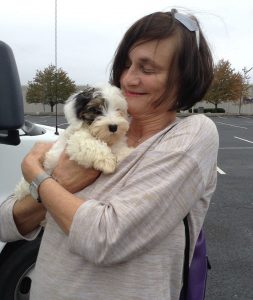
A new puppy
Pip appeared at a most opportune time, just a year after my beloved Mollie had died. A phone call from a breeder:
“I have just the Sealyham Terrier puppy for you; small; perfect conformation; can have babies; can be a champion, if you would like.”
I half listened, none of what she said mattered, except the word – puppy. My heart was pumping again. The day I held that pup in the palms of my hands was my most joyous moment in a very long time. Time stood still that day as I held her close – just as it did a few months later.
Pip, Cancer, and a Benedictine Retreat

Pip
I had turned upon waking to catch Pip from falling off the bed. She was only 7-months old and growing. As I reached for her, that’s when I felt it. A lump, a cyst – no, a lump! No it can’t be, it will go away. Far away – but it didn’t.
Two weeks after diagnosis, I had surgery to remove a healthy portion, or perhaps not so healthy portion, of my left breast. I was alone. I had no close family or support system.
After the surgery, I felt pressured to say yes to everything the white coats ‘in the know’ hurriedly prescribed. But their lineup of statistics by way of line graphs and percentages, longevity and recurrence wasn’t resonating with me.
I was in denial but not so far gone that I couldn’t advocate for myself.
My surgeon gave me all the options and supported my decisions but felt (yes, a surgeon with feelings) obligated to give me the statistics about my lump.
My general physician wouldn’t let me go under the knife until I got my A1C down and a prick to 90 for my diabetes.
Done.
My radiologist had me sign on the line with a witness so many times; my hand went into spasms. Inter-operative radiation was an option I wanted.
My oncologist?
Yes, you can cut me; yes you can burn me, but poison me? I balked and bucked, and whinnied – Noooo! My oncologist didn’t take the news well, but he documented The ‘No’ in silent disagreement. Then left me alone – nothing more to say.
My therapist?
She came after the facts. All my decisions had been made. No regrets. She agreed.
Cancer changes your life.
Your trajectory – Your friends – Your plans – EVERYTHING!
There is no going back to the way you were.
The revelation is that time is of the essence.
Where do I go from here?
How?
When?
The clarity that does come with the “C” word is . . . NOW!
Staying in today – is what I am left with. Today takes priority. Tomorrow can wait and Yesterday holds no ceremony over me any longer.
After declining chemo, my faith kept coming up. Will prayer take over where medicine has no guarantees? Will my faith prolong my life’s journey? My calling?
Needing solitude and a quiet place to reflect I started looking for a place I could take myself, and of course, Pip, my pup.

Pip, in the doorway
What type of retreat did I want? It had to include Pip.
By sheer coincidence, which some say is God’s way of remaining anonymous, a pet-friendly place popped up online. I put on my reading classes to make sure I wasn’t having an out-of-body experience.
The Monastery: A Benedictine Retreat

The Benedictine Retreat
Cancer brought up a need to reckoncile with my faith; a faith that called to me. A spiritual adventure was called for and a Benedictine Monastery I stumbled upon on the web seemed like the perfect place.
Pip and I were the only guests at the hermitage. We had the whole house to ourselves. Except of course for three Benedictine sisters and one yellow lab named Monk.
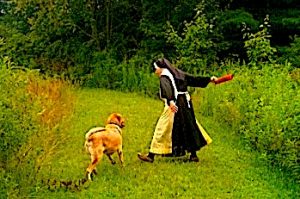
Pip, Monk and the sisters at play
A basket of fresh food appeared on my kitchen table each morning and evening and chapel was only a path’s walk away. The hospitality was like none other I had experienced. I am Protestant, yet the Benedictine Order welcomed me as a sister-in-faith.
When I asked the sisters what I should pack, Sister Sheila replied, “floating fetch toys that Monk can retrieve from our pond.”
“And we so look forward to meeting your, Pip,” she added.
My heart melted.
What a week it was. Contemplation, prayer, community, hospitality, generosity and – my faith restored; a community that was new to me, yet not, growing up amongst the faithful from birth.
We laughed, we played, we shopped, went sightseeing.
The sisters never asked why I had come. Never questioned my faith or the basis of my beliefs. Through the serendipity of an internet search, I reached out and asked for a week of sheltering and they took me in.
As the week came to a close, I asked to gather with the sisters to tell them my story and ask for their prayers.
“Bev, we have been praying for you all week long and will continue with prayer – ‘healing prayers’ each day to sustain you as you continue your life’s journey.”
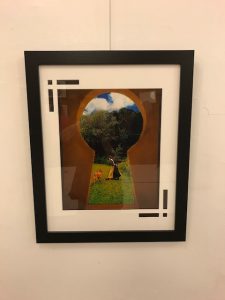
A framed photo from the Benedictine retreat
Our stories, as we look back on our lives, bring up the miracle of randomness, God’s anonymous moments. It made little sense miraculously Pip entered my life when she did.
It made no sense that a faith outside my own would embrace me.
It made no sense that Transfiguration Monastery would enter my life through an Internet search.
No one gets through life alone. God promises us that the ending is worth waiting for – in life – in death – through the magical power of faith.
Serendipity – Stillness – Strength – a perfect threesome. The Father, The Son, The Holy Ghost; And Three Sisters. Incredible Revelations Come in 3’s – and a dog named Monk.
“Seek and you shall find. Ask and it shall be given to you.”
The Power of Faith – God’s Medicine.
Like This Post? Pin It!
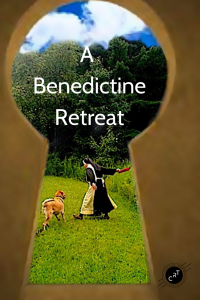
More Guest Posts
Traveling To Heal: 83 Days On TheRoad
Visiting the Galapagos
One Cancer Patient’s Ultimate Travel Bucket List
Seven Ways To Survive The Holidays While Grieving
Luxor Egypt
An Artist’s View of Luxor, Egypt
If you’re interested in learning more about photography (or cooking or film or any number of topics) check out MasterClass All-Access Pass for on-line excellence:

This post contains affiliate links and CancerRoadTrip will be compensated if you make a purchase after clicking on my links.
[et_bloom_inline optin_id=”optin_10″]
What is #CancerRoadTrip and how did it come to be? Read this post to get the backstory!
Follow me on Twitter, Pinterest, Instagram, and at Anti-Cancer Club. Connect with me! I may need a place or two to stay along the way!
Follow my blog with Bloglovin

by Pat Wetzel | Dec 27, 2019 | Guest Post, Road Trip, The Story
Grief and the holidays sadly go hand in hand for many of us. Memories and loses coincide just when we are supposed to be happiest.
Kristyn Lohoff, who lost her husband to cancer, shares some of her strategies for this time of year.
***

The holidays can be a difficult time.
When the holiday season arrives many people find themselves busy planning family gatherings, preparing meals, wrapping gifts, baking cookies, and attending different holiday programs. For people who are living with grief from the loss of a loved one, the holidays can become an overwhelming time. I have learned a lot about how to survive the holidays while grieving.
Grief and The Holidays
I lost my husband in October of 2017, and the first holiday season without him came quickly. Just two months later I was faced with how to celebrate without him. I actually lost seven family members in 26 months, with my husband’s death being the final one. Two other losses were my mother and father-in-law. They had always come to our home over the holidays and that first year without them left my house feeling especially empty.
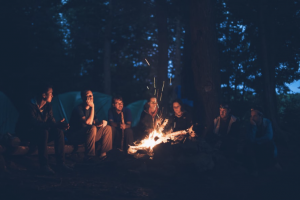
We always gathered around a bonfire
Our tradition of a family gathering with an evening bonfire and a gift exchange was something that I had no motivation to do that first year, but it was something that was very important to all of my children. I found a way to get through that first holiday while grieving.
Surviving the holidays while grieving was so emotionally difficult for me, that I needed two days to recover and be able to get out of bed once again. In spite of this, I felt that the first holiday season was a victory! Here are seven things that I have learned because of my own experiences
Allow Yourself to Feel Without Guilt
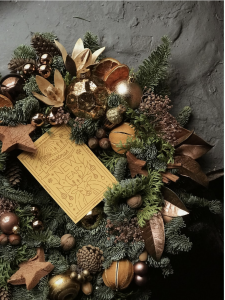
A New Year will bring a new life, different from what you’d imagined.
The holidays are an emotional time. It is Ok if you start to cry, even if you are in line at the grocery store!
You are missing someone special.
Your new life is now very different from what you were used to, it is different from what you envisioned for yourself.
Allow yourself to feel what you are feeling.
Giving yourself permission to let those emotions out will discharge some of the pain so that healing can happen.
Plan Ahead
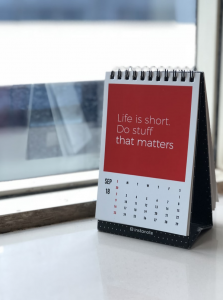
For the first holiday after losing my husband, I was overcome by the intense early grief that I was feeling and there was no way to really plan ahead. Thanks to the help of my adult children, we were able to keep things for our family celebration similar to what they had been in the past. This was very important to them and to my younger daughters.
During my first year as a widow, I learned how to use a bullet journal to help me be prepared and feel less stressed by the responsibilities of daily life.
I used it to plan our second holiday season without my husband. By taking time to reflect about how I wanted to holidays to go, I was able to plan when to do the things that I wanted.
My second holiday season looked very different from my first. I actually took my family on a road trip and we experienced the holiday season in New Orleans, LA while staying in our RV. Being away from home felt good, and that year I didn’t need two days afterwards to recover in bed.
Improvement!
Keep Things Manageable

Lists help us prioritize busy holiday activities
Make a list of all of the things that you feel must be accomplished.
Then, reflect on the things that you truly want to do and the things that you feel you must do.
Do you really need to send holiday cards to every friend or family member you know?
Do you really need to send any?
Let some things go, it’s OK! Trim your old list of things you felt needed to be done down to a new list of only a few “Must Do” items.
It’s OK if you don’t participate in the cookie exchange this year.
It’s OK if you change traditions to make things easier, these changes may make the holiday better for everyone!
Be honest and tell people what you DO want to do for the holidays and what you DO NOT want to do.
Find Time For Yourself

Find time to be alone
Make sure to plan some time for yourself.
Give yourself time to rest. Go for a walk. Listen to music. Take a nap.
Spend time journaling or drawing.
Plan a getaway.
Sit in a coffee shop.
Write a list of ten things that you would like to do for yourself during the holiday season. Write anything that comes to your mind and then select the top three from your list and make arrangements for those things to happen.
If you plan something for just you, especially after the holiday is over, it may give you something to look forward to. This can help you get through some difficult moments.
Find A Way To Honor Your Loved One
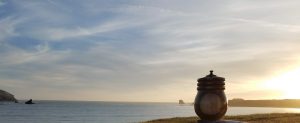
Promise kept. John at the Pacific Ocean.
It may be helpful to find a way to honor and include your lost loved one into part of your celebrations.
You could create a memorial table with pictures of those who are not with you anymore.
You could set a spot at the table for your loved one, cook a favorite dish, or light a candle to remember them.
You could create a memorial decoration or ornament in your loved one’s memory.
You may like to set aside a time to visit their gravesite and leave holiday decorations there.
Talk About Your Loved One
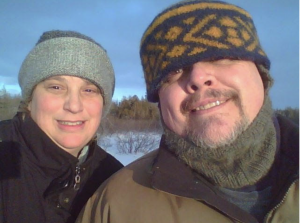
Ready to travel!
It can be helpful to talk about the person who has died as a way to survive the holidays while grieving. Many times people are afraid to bring up the person’s name, but talking about them, saying their name and sharing memories can be very helpful.
By sharing stories over and over, the pain of the loss may lessen. It’s another way to let the pain out and begin to feel joy over time.
Travel and Healing From Grief
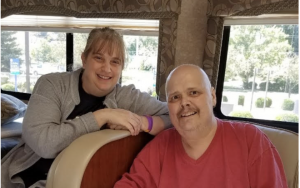
Kristyn and John in their RV
Looking back, it seems that my mother first taught me that travel was a helpful way to deal with grief.
My father died when I was seven, and a couple of months later my mom took our family to DisneyWorld. My parents had been putting money away for this trip for many years, and now, with one less person, it would cost less and she could then afford the trip. Off to DisneyWorld we went!
Over forty years later, I still have vivid memories of that trip and how good it felt to be away from our home where my father had died. For years afterwards, my mother planned trip after trip after trip.
I grew up thinking that she just liked to travel, but once I became a widow myself, I understood the power of travel to heal a grieving soul.
After losing my mother, father-in-law and my husband in a little more than two years, I instinctively began planning a trip that I hoped would bring me and my young daughters some peace. Losses so big would need a monumental trip, and that is exactly what I planned.
Seven months after my husband died I packed up my motorhome and began an epic trip that would log 13,800 miles, included 22 national parks, and provide us with the opportunity to catch up with family and make new friends.

North Rim, Grand Canyon
I created an itinerary of places to go that had been on the bucket list that my husband and I had created together. The trip became a mission for him.
But, as the days went on, I found out that the trip was really about my healing, and the healing of my daughters.
I first noticed this after driving for days from my Wisconsin home, stopping at different places until I had literally run out of road and found myself staring out at the Pacific Ocean in northern California. It was breathtaking.
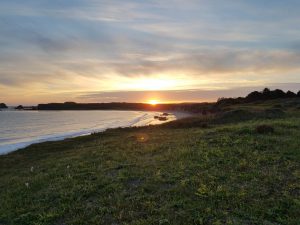
The Pacific Ocean
I sat on the beach watching my girls run around and investigate and just letting my mind wander. I cried, but my soul was also filled with the calm beauty of nature, and I felt a piece of joy seeping back into my life.
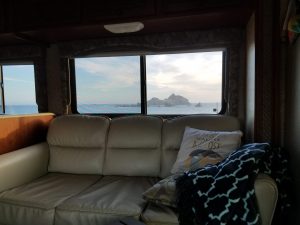
All who wander are not lost: A view from the RV
I did some research and learned about other people who had turned to the powers of nature to heal their broken souls. Theodore Roosevelt lost both his mother and his wife on the same day. Shortly after, he went out to the American West for many months in order to find a way to live with those losses. Nature and travel provided his soul with some comfort, and he later devoted much of his presidency to protecting lands for future generations.
John Muir, from my home state of Wisconsin, went out to California and found the beautiful Beauty in the Yosemite Valley. He later created the Sierra Club and fought for decades so that Yosemite could become one of our first national parks. He later worked to help protect the Grand Canyon and Petrified Forest as national parks.
I have been to over twenty national parks and each time I spend time sitting and letting nature soothe my soul. I enjoy finding out what is special and unique about each park. I let that special thing seep into my body and give me strength to face a new day.
Grief is a marathon.
Whether you are grieving the loss of a loved one, the loss of a pet, the loss of relationship, or the loss of a lifestyle, grief is a daily marathon that we must find the tools around us which will help us to continue moving on.
On my epic RV road trip, I found myself sitting off of a trail along the edge of the north rim of the Grand Canyon without anyone near me.

At the rim of the Grand Canyon
I slipped my coffee and stared at the beauty in front of me. And I felt like I could go on with my life.
Travel is healing. Nature is healing. Putting the two together becomes amazingly powerful.
Find your way to survive the holidays while grieving. Safe travels and happy holidays!
Kristyn is a teacher by day and grief and travel expert every other moment of the day. She lives with her two youngest daughters, a dog and a cat and her motorhome affectionately named CeeCee in Northern Wisconsin. She hopes to find a way to live full-time in her RV. You can visit her website and learn more about her adventures in surviving grief by visiting her website at www.ourclassceelife.com
More Reading on Cancer and Travel
Traveling To Heal: 83 Days on the Road
Visiting The Galapagos
Good Travel Books For The Holidays and All Days
One Cancer Patient’s Ultimate Travel Bucket List
Like This Post? Pin It!
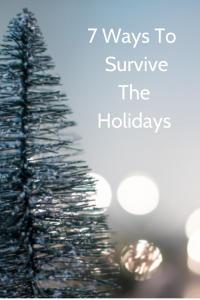
If you’re interested in learning more about photography (or cooking or film or any number of topics) check out MasterClass All-Access Pass for on-line excellence:
 [et_bloom_inline optin_id=”optin_10″]
[et_bloom_inline optin_id=”optin_10″]
What is #CancerRoadTrip and how did it come to be? Read this post to get the backstory!
Follow me on Twitter, Pinterest, Instagram, and at Anti-Cancer Club. Connect with me! I may need a place or two to stay along the way!
Follow my blog with Bloglovin Masterclass YouTube https://www.youtube.com/playlist?list=PL-azJBgG8XSk6z8Ov_mxdczZKkiTyE9cv Blog Lovin’ Follow my blog with Bloglovin
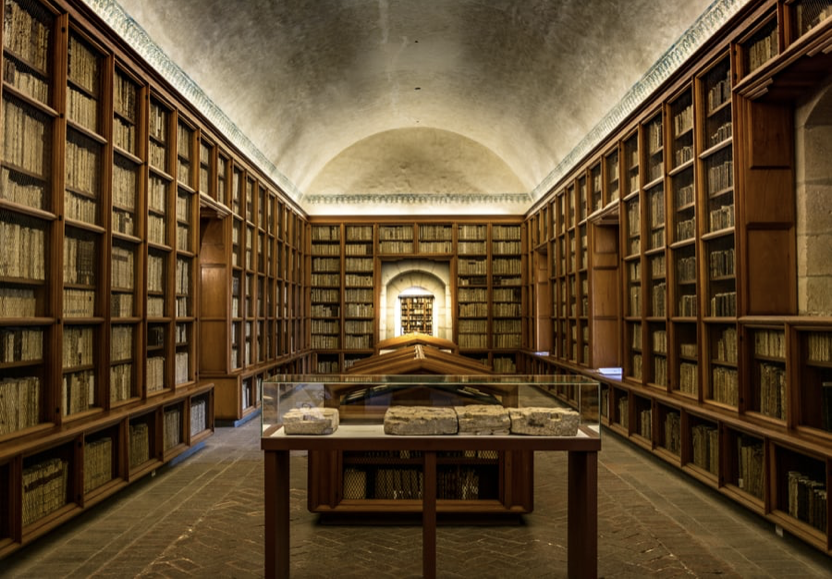
by Pat Wetzel | Dec 15, 2019 | Road Trip, The Story
Good travel books cover new terrain. It may mean mean touring the world. Or perhaps it means looking within.
In either direction, travel always offers adventure. Here is a bit of literary adventure in both directions.
Books for Traveling Within
The journey within oneself is at least as interesting as any world wide voyages. Her are some of the travel books that have been along on my journey:

 I first saw Bernie Siegel many years ago at Yale. He was speaking to an audience of surgeons who, to say the least, didn’t believe in anything that didn’t include a scalpel.
I first saw Bernie Siegel many years ago at Yale. He was speaking to an audience of surgeons who, to say the least, didn’t believe in anything that didn’t include a scalpel.
But Bernie has had the last laugh. Science is finally coming around to his prescient thinking about the power of love and the power of our minds to influence our health and healing.
This book is a classic for a reason. Anyone would be delighted to receive this as a gift, any time of the year.

 The Power of Now has been one of the most influential books of my life. With a great deal of practice on my part, it has shown me that the present moment is what counts. Not your worries; not your words. Just NOW.
The Power of Now has been one of the most influential books of my life. With a great deal of practice on my part, it has shown me that the present moment is what counts. Not your worries; not your words. Just NOW.
For your life’s travels, this book is a companion you won’t tire of.


This is a book I bought long ago, and it’s accompanied me on many travels. Zukav looks at our interactions from a perspective of energy. And when you start thinking in these terms, it provides a trail map for all your travels. This is truly a good travel book for every soulful adventure.

 Joe Dispenza’s story is amazing. He was told he’d never walk again after a horrific biking accident. But using intense visualization he healed a broken back.
Joe Dispenza’s story is amazing. He was told he’d never walk again after a horrific biking accident. But using intense visualization he healed a broken back.
With a scientific bent, he looks at the power of our minds in our daily life and the power we have to heal. He also goes into some fascination meditation technques (that are just mind blowing!).
Love this book. Check it out!

Jim Gordon is someone I’ve admired for many years. He is a Harvard trained psychiatrist who travels the world helping people heal from trauma. He is also the founder of the Center for Mind Body Medicine.
The Transformation is a book that has resulted from Jim’s years of study and teaching, and from his travels across the globe, into war zones and other disaster areas. In this book, he encourages each of us to look within to heal, and he provides the tools to pursue the journey.
I was fortunate enough to interview Jim a few years ago. You can watch the interview here. And if you’re interested in becoming involved in his project, check out cmbm.org

I am currently reading this book and it is a must read. Dean Shrock has oodles of sources, some of which I’ve read (Like Molecules of Emotion by Candace Perth) and others that I haven’t.
This is an excellent book drawing from Dean’s decades of cancer care and his careful research. I heartedly recommend this and all the books on this page.
Good Books For Travel
And then there is the wonderful adventure of travel. The world is a big place; where to go?

 1,000 Places is a classic and one that should live on your wanderlust bookshelf, or on your phone. So many ideas! Want to visit World Heritage Sites? European capitals? Asian temples?
1,000 Places is a classic and one that should live on your wanderlust bookshelf, or on your phone. So many ideas! Want to visit World Heritage Sites? European capitals? Asian temples?
All this and so much more. This is a great place to start your travels. A good travel book for all times.
Travel, for me, is also about history. And in that vein, both fiction and non-fiction offer a chance for travel. A few of my favorites:
 Long before I visited Africa, the stories of British East Africa called to me. There was Isak Dinesen’s Out of Africa, but for me, the book of that era was always West With The Night.
Long before I visited Africa, the stories of British East Africa called to me. There was Isak Dinesen’s Out of Africa, but for me, the book of that era was always West With The Night.
Beryl Markham was an extraordinary woman, pilot, and adventurer. Many years ago, I came across this book and read it again and again. I still go back for the vivid prose. Here’s an example:
“Africa is mystic; it is wild; it is a sweltering inferno; it is a photographer’s paradise, a hunter’s Valhalla, an escapist’s Utopia. It is what you will, and it withstands all interpretations. It is the last vestige of a dead world or the cradle of a shiny new one. To a lot of people, as to myself, it is just ‘home.”
An African adventure in time and space. A must read.


This is a classic for a reason. And an international best seller. It took me many years before I read this, and it’s now one of my favorite travel books.
Santiago, an Andalusian shepherd boy, yearns to travel. So he does. And along the way, he finds himself. A good travel book indeed!


One of the most heart warming reads of all time, chronicling Peter Gethers global travels with his Scottish Fold cat, Norton. Part travel, part adventure and all heart.

 No travel book list is complete without the wisdom of Dr. Seuss. I just love this book. It starts:
No travel book list is complete without the wisdom of Dr. Seuss. I just love this book. It starts:
“Congratulations! Today is your day. You’re off to great places. You’re off and away!
You have brains in your head. You have feet in your shoes. You can steer yourself any direction you choose.”
And so starts any great adventure.
We are giving healing journeys to people to discover their world anew after cancer treatment. And we’ll be capturing it all on film so that you can share in the adventure.
Seven Travelers, Seven Stories, One Bucket List Location
Be a part of the project. Click here to learn more.
And be sure to sign up on our mailing list to stay in the know about the film project, our travels and so much more!
Like This Post? Pin It!

If you’re interested in learning more about photography (or cooking or film or any number of topics) check out MasterClass All-Access Pass for on-line excellence:
 [et_bloom_inline optin_id=”optin_10″]
[et_bloom_inline optin_id=”optin_10″]
What is #CancerRoadTrip and how did it come to be? Read this post to get the backstory!
Follow me on Twitter, Pinterest, Instagram, and at Anti-Cancer Club. Connect with me! I may need a place or two to stay along the way!
Follow my blog with Bloglovin
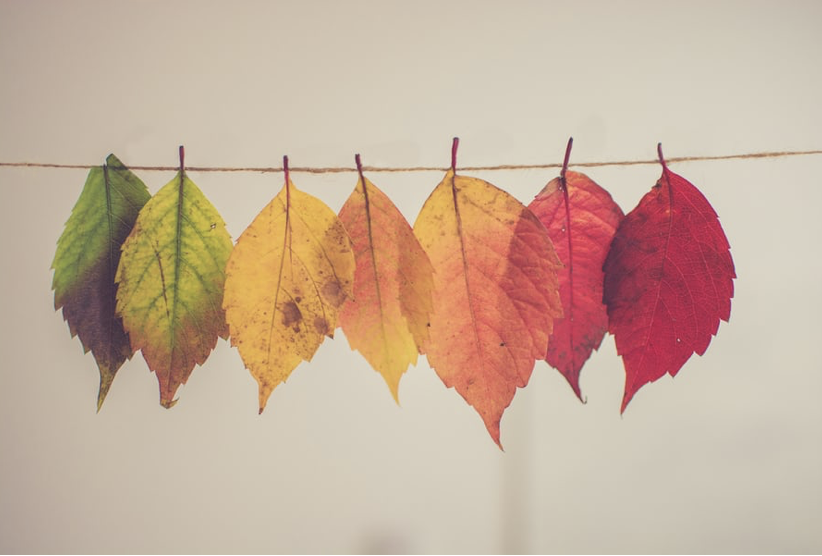
by Pat Wetzel | Nov 24, 2019 | Healing, Road Trip, The Story
Thanksgiving is a time for gratitude, especially if your life has been touched by cancer. Along those lines, let me share some recent encounters of the cancer kind.
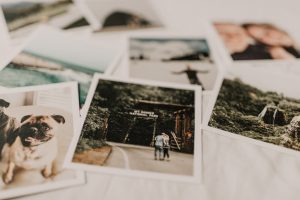
Take a moment to share your kind thoughts with someone dealing with cancer. Become part of the project.
Cancer: Prohibited Topic
I had a most interesting conversation the other day. I was introduced to a woman who was not very enthusiastic or curious about CancerRoadTrip.
This alone is an anomaly.
The usual response is a shared cancer story, either one’s own or that of a friend.
She went on to reveal that she had had a mastectomy and it wasn’t really such a big deal.
But her doctor was excellent. She had excellent care. Her doctor, she insisted, was the best.
They didn’t get clean margins, so she had to do radiation she said. Then 5 years of estrogen restricting drugs.
It wasn’t a big deal, she insisted.
Her doctor was excellent.
Her cadence was flat. Her affect lacked depth. She was impeccably groomed. A handsome and attractive woman, 60 something I would guess.
Her response to me was so blank, I had to ask:
Do you ever worry about recurrence?
“I’m 5 years out”, she informed me, as if this magical line in the timeless sand spoke volumes that needed no explanation.
“Although they are now saying you want to be 7 years cancer free,” she added.
It really wasn’t a big deal.
My doctor was the best.
The conversation was over before it had even begun.
I’ve met people like this before. Cancer was a blip. It’s gone, never to return (fingers crossed). It’s filed away with other unpleasant thoughts, buried deep, not to be resurrected.
EVER.
NO MATTER WHAT.
I think I envy them their certainty. Their ability to disregard their brush with mortality as if it never happened. Their seeming lack of morbid imagination.
Or do I?
Is denial as good a way as any to deal with this retched disease? Is there any value in reflection, in integrating the experience into one’s life for the lessons learned and the perspective gained? And to what end does an examination of one’s scars finally lead?
Is recognition of limited time “good” or “bad”? Can a binary answer even begin to address the recognition of mortality?
For many, cancer brings a deep seated appreciation of life. Can one have this wonder of the moment without grasping its fragility? Like a photograph, the magic of light and composition is so fleeting, made of nothing but pixels of shadow.
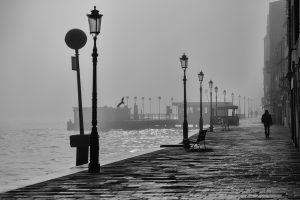
“Taking pictures is savoring life intensely every hundredth of a second.”
Marc Riboud
Walking the Cancer Walk
Another conversation, this time with a woman whose friend was dealing with bowel cancer.
“We used to walk every day,” she said.
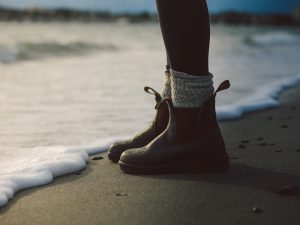
PhotoCredit: Max Conrad on Unsplash
“Now she has continence issues, so she can’t really go out for a walk anymore. I never see her.”
She went on to talk about all the ways her former friend had fallen out of her life. How she could no longer participate in even simple things.
I suggested she leave a note on the website, to be included in the film credits.
A cloud came over her. A darkness. She seemed, well, ashamed.
I wondered if this was the first time she talked about her friend and her absence from her life. If it was the first time she reflected on the loss, both for her and her former walking buddy.
My intent was not to make her feel badly, but to give her a positive way to reach out and perhaps release some of her emotion.
“I bet there’s a story behind CancerRoadTrip,” she responded after a brief pause in the conversation.
I started to tell the tale, but the speaker on the stage picked up the microphone and started introducing a panel. There was no place for conversation.
I gave her a card, thanked her for the conversation, and left.
I never heard from her. I wonder if her friend did.
“Kind words can be short and easy to speak, but their echoes are truly endless.” -Mother Teresa

Photo by Ty Williams on Unsplash
Cancer and Caregivers
Another encounter, this time with a young woman who had taken care of two relatives with cancer.
She looks so young to have shouldered such responsibility. Her smooth face belies the experiences in her soul.
What do you say to someone who finds their young life consumed by death?
The daughter of one friend started a group called The Dead Parents Society. She was a teenager when her father died of cancer and she had no peer group. Her other friends couldn’t understand the depth of the loss she had experienced.
Another young woman interrupted her life and career to take care of her mother and two younger siblings. She is now in her early thirties, working to restart her young life. Loss, anger, isolation…she’s seen it all. To cope, she is giving back through cancer advocacy groups.
The stories go on. Everyone has a story to tell because cancer has impacted all of us.
This holiday season, please take the time to reach out to someone dealing with cancer.
Just say hi, send a text, show your care. Your kind words may mean more than you’ll ever know.

Photo by Adam Solomon on Unsplash
More Reading On Gratitude and Cancer
Gratitude: A Habit for All Times
CancerRoadTrip: The Film
Labyrinth Walking In Santa Fe
Traveling With Cancer: A One Year Anniversary
Like This Post? Pin It!
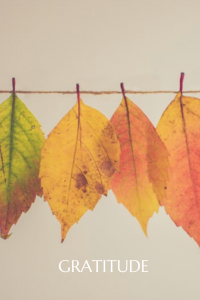
If you’re interested in learning more about photography (or cooking or film or any number of topics) check out MasterClass All-Access Pass for on-line excellence:
 [et_bloom_inline optin_id=”optin_10″]
[et_bloom_inline optin_id=”optin_10″]
What is #CancerRoadTrip and how did it come to be? Read this post to get the backstory!
Follow me on Twitter, Pinterest, Instagram, and at Anti-Cancer Club. Connect with me! I may need a place or two to stay along the way!
Follow my blog with Bloglovin
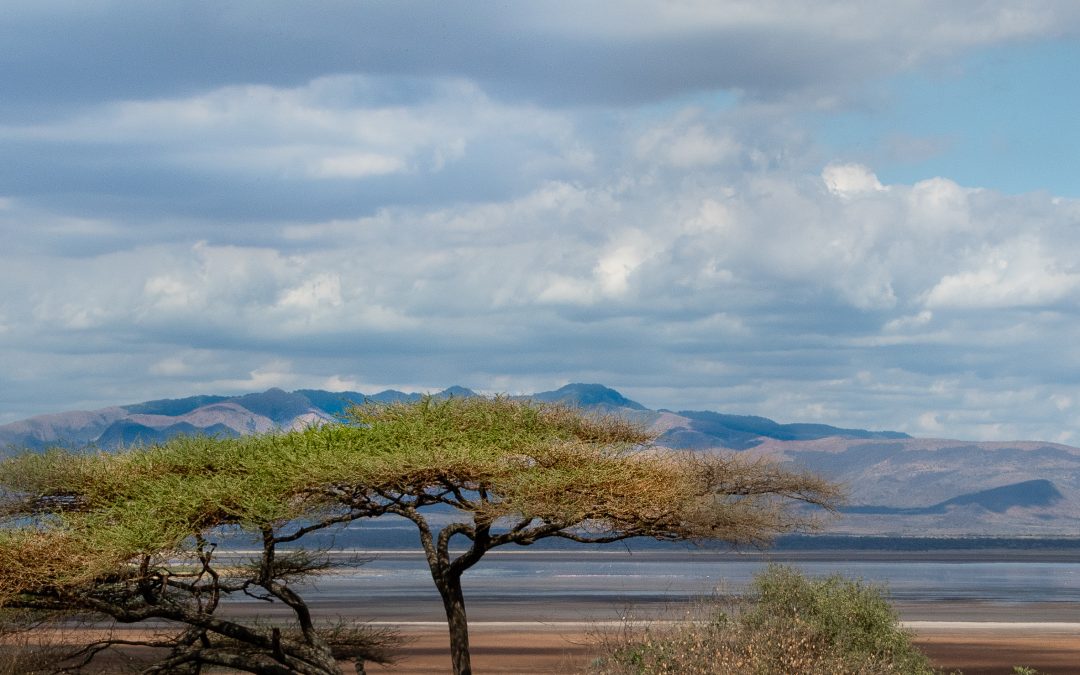
by Pat Wetzel | Nov 17, 2019 | Road Trip, The Story
Lake Manyara beckons as our Tanzania photo safari begins.
The vehicle is stocked; our camera equipment ready; and the dusty road blows by. Lake Manyara is not too long a drive. It’s just 126 km from Arusha, about an hour and a half.
This particular road is paved and passes groups of houses here and there. Don’t let this lead you to false expectations. Dusty two lane washboard roads with no amenities in sight are the norm.
We breezed through regular police checkpoints along the route, undoubtedly due to our tourist status.
And that day, on my Tanznaia photo safari, I started my habit that I called my drive-bys.
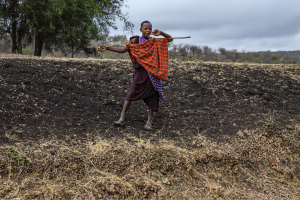
There were so many interesting people and sites along the road. But our mission was wildlife photography, not local culture. So I set my camera on a high shutter speed, and hoped I’d capture some images of life along the way.
Lake Manyara National Park is a wildlife refuge in western Tanzania and the seventh largest lake in the country. The origin of its name is uncertain. The Maasai word emanyara refers to the enclosure around a home, which is mimicked in nature by a 600 meter rift escarpment that surrounds the Lake. Or perhaps the Mbugwe word manyero which refers to a place where animals drink water is the source of the name.
Baboons, flamingos and tree climbing lions in habit the area, as well as hundreds of other species. It’s a perfect introduction to a Tanzania photo safari.

More Reading on a Tanzania Photo Safari
Kili, Culture and Connection
Photo Gallery: Elephant Love in the Serengeti
An African Photo Safari With A Nikon Ambassador
Safari Clothes: Packing for Safari
An African Photo Safari: Photo Equipment Packing List
Visas and Vaccinations for Tanzania
Like This Post? Pin It!
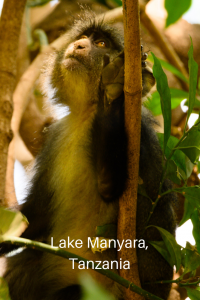
If you’re interested in learning more about photography (or cooking or film or any number of topics) check out MasterClass All-Access Pass for on-line excellence:
 [et_bloom_inline optin_id=”optin_10″]
[et_bloom_inline optin_id=”optin_10″]
What is #CancerRoadTrip and how did it come to be? Read this post to get the backstory!
Follow me on Twitter, Pinterest, Instagram, and at Anti-Cancer Club. Connect with me! I may need a place or two to stay along the way!
Follow my blog with Bloglovin
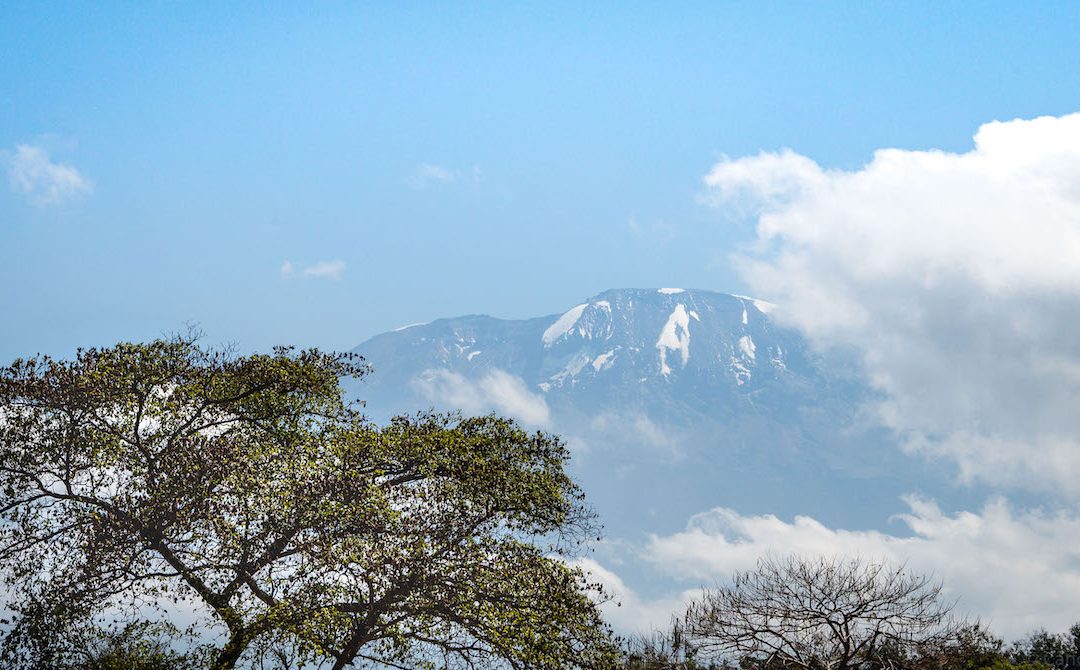
by Pat Wetzel | Nov 4, 2019 | Road Trip, The Story
Tanzania Days 2 and 3
I had another day before joining up with the other photographers in the group. On my agenda was Mt. Kilimanjaro.
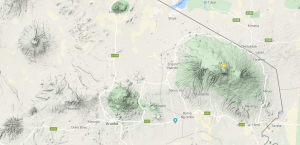
Kili is in eastern Tanzania. Our travels towards the Serengeti would take us west.
A trip to Tanzania without at least seeing Kilimanjaro (“Kili”) just wasn’t an option. Our photographic travels were taking us west and north towards the Serengeti, not east towards the renown mountain.
So with my second free day, after a hike around Lake Duluti, it was off to Kili to see it, if not climb it.
Kilimanjaro
Kilimanjaro is a legend.
Its local name depends on who you talk to. In Swahili it is “‘Mountain of Greatness” or “White Mountain” or in Maasai, “The Mountain of Water”.
Kili was first summited in 1889 by German geology professor Hans Meyer.
More recently a Swiss-Ecuadorian, Karl Egloff, set a speed record for the mountain, going up by the Umbwe route and back via Mweka in just under 7 hours.
Most people take 6 days or so just for the ascent, and about 2 days for the descent.
There are seven established routes on the mountain, each with its own pros and cons: Marangu, Machame, Lemosho, Shira, Rongai, Northern Circuit and Umbwe.
The various approaches offer different experiences, ranging from the gentler Marangu route (which also has dorm style sleeping quarters that are especially popular during the rainy season) to the steeper but popular Machame route. Some excellent information on the various routes can be found here.
My route was via the Arusha-Himo Road and safari vehicle. And back in time for a multi-course dinner served in the English inspired dining room.
My driver, “Gift” (an English translation of his Swahili name) was the same person who picked me up at the airport, and, I learned, he would be our driver for the entire trip.
There is a saying in Swahili:
“Jina jema hungara gizani”
A good name shines in the dark
And that was certainly true of Gift who became part of our safari adventure.
Becoming a safari driver requires a fair amount of training, and that training was evident in Gift. From managing sometimes difficult road conditions (and not sending us plummeting off the road near the Ngorongoro Crater like another less fortunate vehicle) to finding extraordinary wildlife, Gift was an integral part of our safari .
Gift also took care to be sure our double diesel fuel tanks were always full; the vehicle cleaned and washed every night; that the cooler was stocked with plenty of water; and he generally looked out for all of us.
We left for Kili in the morning. Heading east along the Arusha-Himo Road, I wondered if we’d even be able to see Kilimanjaro. The 20,000’+ mountain is often shrouded in clouds. But as luck would have it, the clouds broke and the mountain appeared.
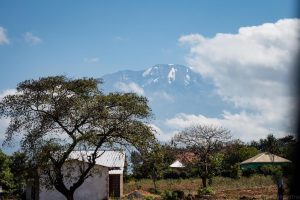
Kilimanjaro emerges from the clouds.
On the drive to Kilimanjaro, one leaves behind the dusty plains and as the altitude rises, one enters a richer, lusher climate belt. Women with huge clusters of bananas balanced atop their heads walk the road. The jungle becomes green and dense.
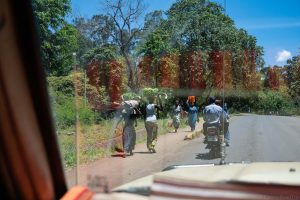
The road to Kilimanjaro taken from the safari vehicle
And then the gate to Kili appears. Groups laden with hiking gear gather, ready for a hike to the summit which can run from 5-9 days. Sherpas and other support staff are available to carry the food, tents and heavier gear for many hikers.
The sherpa assistance can be especially appreciated on the last day of the ascent. The push to the summit, everyone agrees, is tough. The brutal cold makes moving difficult, but the view from over 20,000 feet definitely compensates.
Like most national parks in Tanzania, the entry fees can be stiff. Hiking Kilimanjaro runs from $1,000 at the very low end to $4,000 and above. The government mandates a guide service plus fees of $600-700 per climber.
While the climb is not technical, it is not without risk. Every year about 1,000 people have to be evacuated and it is said that the number of deaths is under-reported. Being very fit, and having an experienced, reputable guide is essential.
The drive to Kili also offered some interesting glimpses into local culture. The photos below were taken mostly from a moving vehicle, but they give a sense of the environment and the people, from the towns and savannahs to the jungle at the base of Kilimanjaro.
[rev_slider alias=”template-Kili”][/rev_slider]
Being shepherded about by Gift, I found myself in a bit of a tourist bubble. Mingling was difficult.
Along with my fellow photographers, we stood out, by virtue of our skin color, our clothes and our own culture.
Safety was also a potential issue. On the one hand, not much intimidates me. On the other hand, wandering around alone with $15 -$20,000 of photo gear on one’s back was probably not the smartest idea here, or anywhere else for that matter.
But from my travels, a few observations.
I noticed that many of the women had beautiful, complicated hair styles, consisting of long braids gathered together, sometimes in a ponytail, sometimes in gravity defying loops. I wish I had taken photos of them. They were truly stunning.
And hair, I learned, is a significant part of the cultural heritage for the 125 ethnic groups, speaking 120 languages across modern day Tanzania.
From Africa.com on African Women’s Hairstyles:
“Hair played a significant role in the culture of ancient African civilizations. It symbolized one’s family background, social status, spirituality, tribe, and marital status.
As early as the 15th century, different tribes used hair to show one’s social hierarchy. Members of royalty wore elaborate hairstyles as a symbol of their stature…”
Hair styling was also a part of the social culture, and remains so for many tribes.
The tradition of hair in African women would also emerge during our visit to the Arusha Cultural Center. More on that below.
Out and about, I also noticed that many women carried substantial loads carefully balanced on their heads.
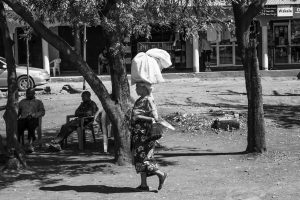
Woman walking along the roadside, Tanzania
Other cultures, like the descendants of the Tewe people in the southwest U.S., created pottery especially designed to sit atop one’s head.
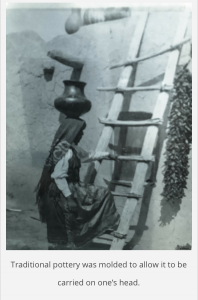
I find it curious that this tradition spans continents and centuries, tens of thousands of miles apart.
How is it that disparate cultures share so much in common?
Day 1 of the Official Safari: The Arusha Cultural Center
On Day 1 of the official safari, the group of 3 professional photographers and myself met up to visit the Arusha Cultural Center. As would become our routine for the next week and a half, Gift drove.
The Center houses all sorts of African art. Mezzanines open to a central, interior courtyard. Walkways curl up from floor to floor, with each level showcasing a different type of art. Hand carved chairs, tribal masks, painting, bronzes (old and new), and photographs were among the works presented.

Inside, the open gallery winds its way up numerous levels, all filled with African art.
And under construction is a new pavilion celebrating the work of Jane Goodall. We had just missed her by a week or so.
With or without a chance to meet Jane Goodall, the entire Cultural Center is simply amazing. The collection of masks on the lower level was, for me, totally captivating:

Okui mask from the Punu people of Gabon
This particular mask shows the Mmwo Sprit Maiden with an elaborate hairstyle. From the Arusha Cultural Center:
“The mask would be worn with a colorful costume covering her body. Although the mask has known as duma or mvidi, it represents a female guardian spirit in the initiation of young girls….
The refined features and elaborate coiffure of the Puno mask mirrors the appearance of tribal women. The white pigments…allude to the anti-witchcraft powers of this group. The Puno make only mask women, with elaborate hairstyles, and white kaolin pigments. They are worn by Moukouji initiates, who are often on stilts.”
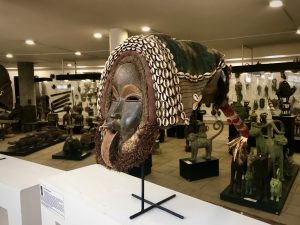
Another mask from the collection

Dan Mask High Crest Libera
From the Cultural Center:
“The Dan mask are made of various materials, included are leather, metal fabric…This Dan mask is classic in its features with slim, closed eyes and a distant expression…
The Dan believe that spirits, known as “Du”, live in the forests and manifest themselves to humans in masks and masquerades, instructing and sustaining the Dan in life.”
And the Benin Bronzes which dated from the Benin or Edo Empire (1440-1897) was produced mainly for the court of the Oba of Beni. For more than 500 years, West African artists created objects for use in divine rituals, to honor the king.
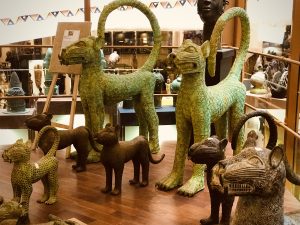
Benin bronzes were crafted to honor the king

Close up of feline bronzes at the Arusha Cultural Center
More contemporary bronzes reflect the natural world:
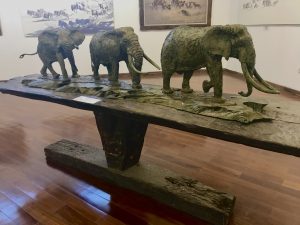
Elephants in bronze atop a wooden table
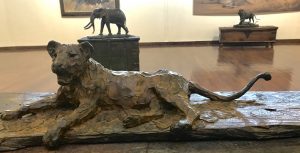
Lioness Sitting, by Mike Ghaui
In addition to the art, some of which is for sale, a small village of shops offers African spices, gems and wares. Rather than shopping, I settled in for yet another amazing cup of coffee, a Zanzibar coffee filled with cardamon, cinnamon and spice.
Beans, Rice and Photography
In addition to Kilimanjaro and the Cultural Center, a visit to the cash machine for some local currency (shillings) was in order.
And I was on a quest for rice or beans.
Not to eat, but to fill my bean bag.
A photographic bean bag is a vital piece of equipment for a safari. It’s a small or large bag, filled with something like beans or rice, that sits atop the roofline or on a window sill in a vehicle. It provides a stable base for long lens photography when a tripod isn’t practical.
In Arusha, we visited a very modern market. It was immaculate, accepted VISA or cash, and had everything from candy and meat to beans and rice.
I bought more than a few pounds of rice. I’d later give the rice to Gift, to distribute to someone who could use the food.
***
The end of our first official safari day in Arusha was also the beginning of the educational portion of this safari.
The group met up, in the lovely bar back at the Serena, for our first session with Kristi.
Kristi’s grasp of photography, history and her eye for detail is astounding. She sees things the rest of us simply don’t. Time and time again, she would astound me as we traveled through the Tanzania country. We would be looking at the same scenery, yet seeing totally different images.
The first educational session focused on an overview of photography, and some key concepts for us to start integrating into our own pictures. For the first time, I felt like I had some context to analyze what creates a compelling image.
Each session with Kristi opened my eye to a new perspective on photography, composition and how I might start to develop my own, more sophisticated voice in film.
And I had so much to learn.
More Reading On Tanzania
Photo Gallery: Elephant Love in the Serengeti
An African Photo Safari With A Nikon Ambassador
Safari Clothes: Packing for Safari
An African Photo Safari: Photo Equipment Packing List
Visas and Vaccinations for Tanzania
Like This Post? Pin It!
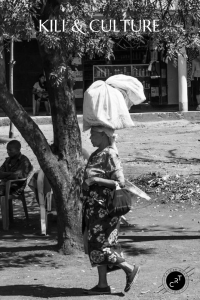
If you’re interested in learning more about photography (or cooking or film or any number of topics) check out MasterClass All-Access Pass for on-line excellence:

[et_bloom_inline optin_id=”optin_10″]
What is #CancerRoadTrip and how did it come to be? Read this post to get the backstory!
Follow me on Twitter, Pinterest, Instagram, and at Anti-Cancer Club. Connect with me! I may need a place or two to stay along the way!
Follow my blog with Bloglovin

































































